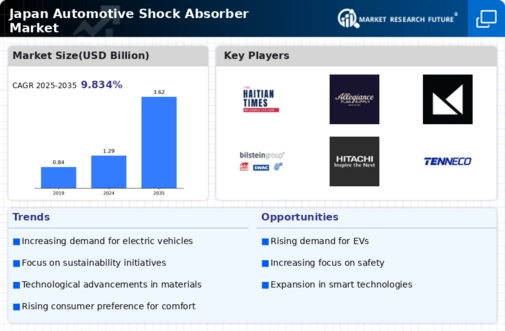Rising Demand for Vehicle Comfort
The automotive shock-absorber market in Japan experiences a notable increase in demand driven by consumer preferences for enhanced vehicle comfort. As Japanese consumers prioritize smooth rides and reduced vibrations, manufacturers are compelled to innovate and improve shock-absorber technologies. This trend is reflected in the growing sales of premium vehicles, which often feature advanced suspension systems. In 2025, the market for high-performance shock absorbers is projected to grow by approximately 15%, indicating a shift towards products that offer superior comfort. Consequently, manufacturers are investing in research and development to create shock absorbers that not only meet but exceed consumer expectations for ride quality, thereby propelling the automotive shock-absorber market forward.
Shift Towards Lightweight Materials
The automotive shock-absorber market in Japan is witnessing a shift towards the use of lightweight materials. This shift is driven by the automotive industry's focus on fuel efficiency and performance. Manufacturers are increasingly adopting materials such as aluminum and composite materials to reduce the weight of shock absorbers. This transition not only improves vehicle handling but also contributes to lower fuel consumption. In 2025, it is anticipated that the market for lightweight shock absorbers will grow by approximately 12%, reflecting the industry's commitment to sustainability and efficiency. As a result, the automotive shock-absorber market is likely to evolve, with manufacturers prioritizing the development of innovative, lightweight solutions.
Growth of the Automotive Aftermarket
The automotive aftermarket in Japan is experiencing robust growth, which positively impacts the automotive shock-absorber market. As vehicle ownership increases, the demand for replacement parts, including shock absorbers, rises correspondingly. In 2025, the aftermarket segment is projected to account for nearly 30% of the total shock-absorber market, driven by the need for maintenance and upgrades. This trend is further fueled by the increasing age of vehicles on the road, leading to a higher likelihood of shock absorber replacements. Consequently, aftermarket suppliers are expanding their product offerings, thereby enhancing the overall competitiveness of the automotive shock-absorber market.
Government Regulations on Vehicle Safety
Government regulations regarding vehicle safety standards significantly influence the automotive shock-absorber market in Japan. Stricter safety requirements compel manufacturers to enhance the performance and reliability of shock absorbers. Compliance with these regulations often necessitates the development of advanced shock-absorber technologies that can withstand rigorous testing and provide optimal performance. As a result, the market is expected to see a growth rate of approximately 10% as manufacturers adapt to these evolving standards. This regulatory environment not only ensures consumer safety but also drives innovation within the automotive shock-absorber market, as companies seek to meet and exceed regulatory expectations.
Technological Advancements in Suspension Systems
Technological advancements play a crucial role in shaping the automotive shock-absorber market in Japan. Innovations such as adaptive and semi-active suspension systems are gaining traction, allowing for real-time adjustments based on driving conditions. These systems enhance vehicle stability and comfort, appealing to both manufacturers and consumers. The integration of such technologies is expected to increase the market share of advanced shock absorbers by around 20% in the coming years. As Japanese automotive manufacturers strive to remain competitive, the adoption of cutting-edge suspension technologies is likely to drive growth in the automotive shock-absorber market, fostering a landscape of continuous improvement and innovation.




















Leave a Comment